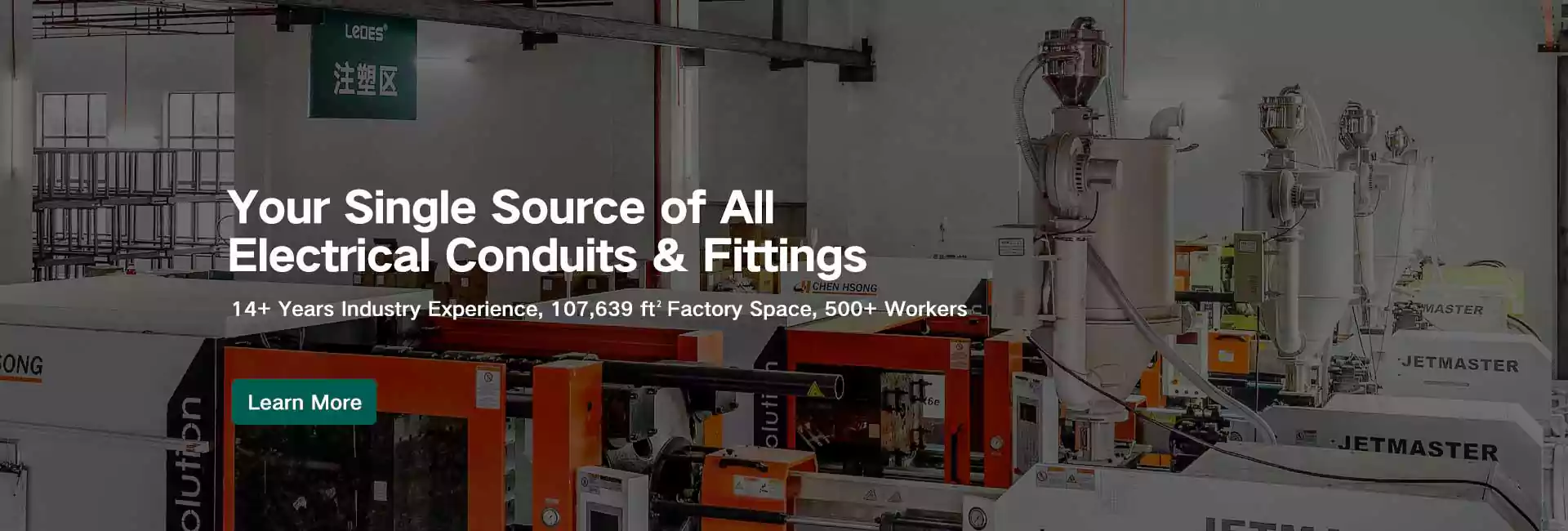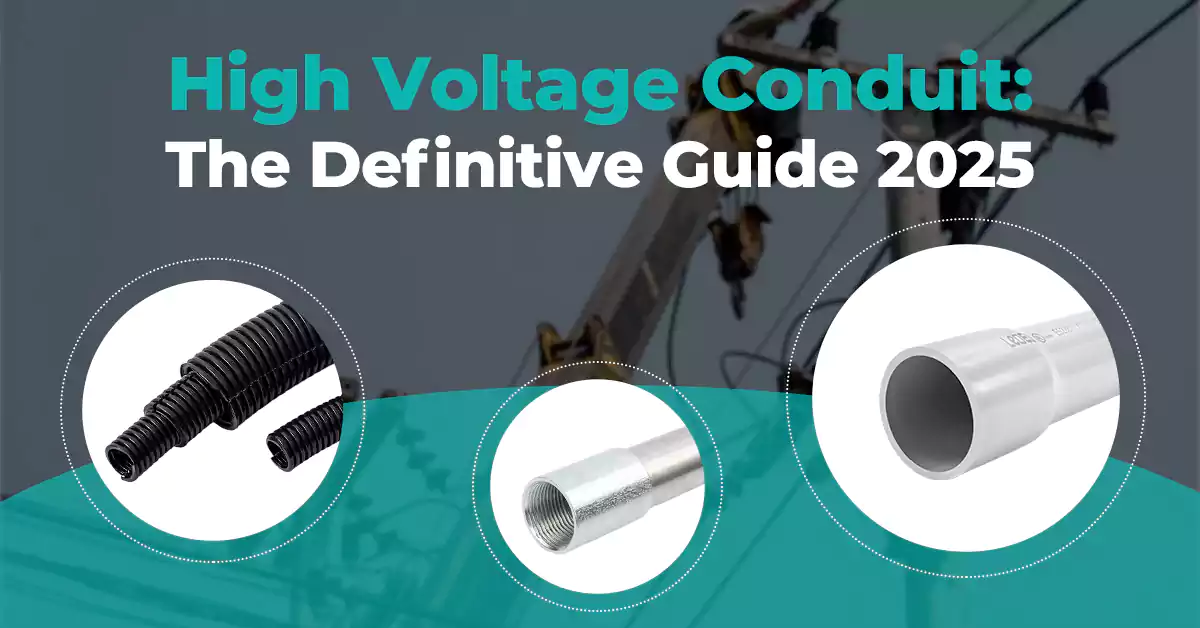
Table of Contents
High voltage power transmission stands as a cornerstone of modern electrical infrastructure, enabling the efficient delivery of electricity across long distances with minimal energy loss. This efficiency is not just a technical preference, it’s a necessity. High voltage conduit systems are essential for powering industrial machinery, supporting utility-scale renewable energy, operating expansive data centers, and fueling fast-growing electric vehicle (EV) charging networks. As the global demand for reliable, high-capacity power systems intensifies, the components that support this flow become more critical than ever.
At the heart of this high-stakes electrical environment is one often-overlooked element: electrical conduit. Far more than just a hollow tube, high voltage conduit is a specialized protective system designed to encase and route powerful electrical cables safely and efficiently.
This 2025 guide serves as the definitive resource for understanding, selecting, and implementing high voltage conduit systems. Whether you’re a utility engineer designing a substation, a contractor working on a wind farm, or a facility manager overseeing industrial power upgrades, this guide will provide practical insights into:
- What defines a “high voltage” conduit system
- The most common conduit types and materials used
- Applicable standards and regulatory codes (NEC, IEC, UL, IEEE, and more)
- Installation best practices and common pitfalls to avoid
- Specialized applications like underground runs, hazardous environments, and renewable energy projects
- New trends in conduit design for digital monitoring, fire safety, and sustainability
With electrical infrastructure becoming more complex and interconnected, understanding high voltage conduit in detail is essential to ensuring safety, uptime, and future readiness. Let’s begin by defining exactly what qualifies as high voltage, and what that means for conduit selection.
Understanding High Voltage
To effectively design, install, and maintain high voltage conduit systems, it is essential first to understand what constitutes high voltage. While the term is commonly used across the electrical industry, its definition can vary depending on regional standards, industry sectors, and application types.
What Is High Voltage?
At its core, high voltage refers to electrical potential large enough to cause harm to people, damage to equipment, or insulation breakdown in wiring systems. It exceeds the limits typically used in residential or standard commercial electrical systems, and is necessary for efficient transmission of power over long distances or to energy-intensive equipment.
However, there is no universal voltage threshold that defines ”high voltage.” Instead, classifications depend on institutional standards. Below are the most widely recognized definitions.
Voltage Classification by Standards
To clarify how voltage levels are categorized across international standards, the table below summarizes IEC and ANSI/IEEE voltage classes:
Voltage Class | IEC Definition | ANSI/IEEE Definition (US) |
Low Voltage (LV) | ≤ 1,000 V AC or ≤ 1,500 V DC | ≤ 600 V |
Medium Voltage (MV) | 1 kV to 35 kV | 601 V to 69 kV |
High Voltage (HV) | > 35 kV | 69 kV to 230 kV |
Extra-High Voltage (EHV) | > 230 kV | 230 kV to 765 kV |
Ultra-High Voltage (UHV) | > 800 kV | > 765 kV (UHV systems may exceed 1,100 kV) |
Voltage thresholds may vary slightly depending on the country, utility practices, and specific industry sector.
Application Contexts for High Voltage
Understanding these classifications is not just academic—it directly impacts conduit system selection and installation methods. For example:
- Utility Transmission Lines: Often exceed 115 kV and require robust, weather-resistant, and UV-stable conduit.
- Industrial Distribution Systems: Typically operate between 4.16 kV and 34.5 kV, needing conduit with high dielectric strength.
- EV Infrastructure & Renewable Energy: May use medium-to-high voltage connections to interface with power grids.
What is High Voltage Conduit?
High voltage conduit is a specialized type of electrical conduit designed to encase, protect, and route conductors that carry high voltage electrical power – typically defined as voltages exceeding 1,000 volts AC or 1,500 volts DC, depending on regional standards. These conduits serve as a critical part of high voltage electrical systems by ensuring electrical safety, mechanical protection, and compliance with regulatory requirements.
Engineered to withstand elevated electrical stresses, high voltage conduits are constructed from robust materials such as galvanized steel, aluminum, or heavy-wall PVC, and may include features like flame resistance, UV resistance, and corrosion protection. They are used in applications such as power distribution networks, utility substations, industrial facilities, and renewable energy infrastructure, where the insulation, containment, and environmental protection of high voltage wiring is essential.
The Role of Conduit in High Voltage Systems
In high voltage electrical infrastructure, the risks and performance demands are significantly greater than in standard or low-voltage environments. As voltage levels increase, so do the consequences of insulation failed, physical damage, and environmental degradation. That’s why conduit systems play a critical, multifaceted role – far beyond simply holding wires.
1. Physical Protection
High voltage conductors are often routed through environments that pose mechanical hazards, such as industrial sites, outdoor substations, underground utility corridors, or high-traffic zones. In these settings, conduits:
Shield cables from impact, abrasion, and crushing
Prevent rodent damage and equipment interference
Protect against accidental contact with energized components
For example, rigid metallic conduit (RMC) or high-impact-rated fiberglass conduit may be used in substations where physical durability is essential.
2. Environmental Isolation and Resistance
High voltage systems are commonly exposed to extreme weather, corrosive substances, moisture, and UV radiation. Conduits serve as a barrier between environmental threats and live conductors. Depending on the material, conduit can offer:
- Waterproofing for underground or submerged installations
- UV resistance for long-term exposure in solar and transmission applications
- Corrosion resistance in coastal, chemical, or industrial sites
- Thermal stability to endure temperature extremes without deformation
This environmental protection is especially critical for ensuring long-term reliability in renewable energy farms, energy storage systems, and utility-scale transmission networks.
3. Electrical Safety and Insulation
High voltage cables have thick insulation, but conduit adds a vital second layer of protection that:
- Reduces risk of arc faults or flashovers in case of insulation breakdown
- Prevents direct human contact with live conductors
- Contains faults and delays the spread of electrical fires
- Supports grounding and bonding where applicable (especially in metallic conduit systems)
In addition, non-metallic conduit with high dielectric strength is often preferred in specific high voltage applications where electrical isolation from ground is necessary.
4. Cable Organization and Maintainability
High voltage systems frequently involve complex routing, long cable runs, and future upgrades. Conduits contribute to organized cable management, allowing:
Easier pulling, replacement, and inspection of conductors
Defined bend radii and spacing to avoid stress on cables
Reduced electromagnetic interference through separation and shielding
This is especially relevant in infrastructure such as wind farms, battery storage systems, and EV charging depots, where cable density and maintenance access are important design factors.
5. Regulatory and Code Compliance
High voltage installations are subject to stringent regulations under NEC, IEEE, IEC, and utility-specific standards. Conduits help meet these codes by providing:
Fire-rated containment in critical environments (e.g., tunnels, data centers)
Required clearances, sealing, and grounding in classified or hazardous locations
Compliance with UL, CSA, AS/NZS, and other national safety standards
Failure to use properly rated conduit can result in safety violations, equipment failure, and legal liability, making compliant conduit systems essential from both a technical and regulatory standpoint.
6. Structural Integration
In large-scale projects, conduit systems often integrate with support infrastructure, including:
Cable trays and raceways
Pull boxes, junction boxes, and enclosures
Anchors, spacers, hangers, and other mechanical supports
Well-planned conduit systems contribute to the structural integrity, space efficiency, and operational resilience of the overall installation.
As voltage levels, environmental challenges, and system complexities increase, so too does the importance of selecting the right conduit system for the job.
10 Types of High Voltage Conduits
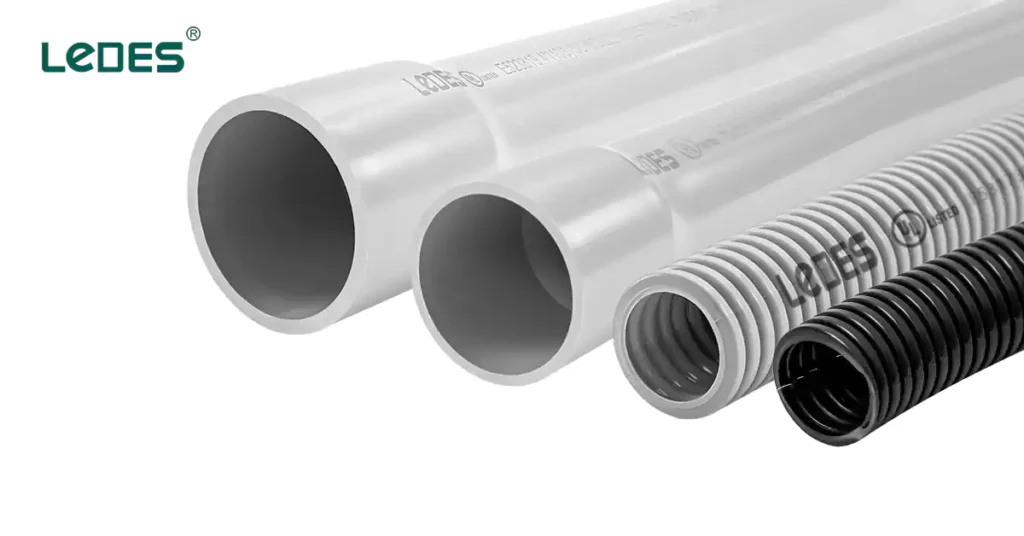
Selecting the right conduit for high voltage systems is a critical step in ensuring electrical safety, operational reliability, and regulatory compliance. Conduit must not only protect cables from mechanical and environmental stress but also provide suitable electrical insulation or grounding properties based on the application. High voltage conduits come in a variety of types, generally categorized by their material—nonmetallic (PVC, HDPE, RTRC) and metallic (RMC, IMC, LFMC, aluminum).
PVC Conduit for High Voltage Systems
PVC (Polyvinyl Chloride) conduit is one of the most commonly used nonmetallic conduit types for high voltage installations, particularly in underground and corrosive environments. Its combination of corrosion resistance, electrical insulation, affordability, and ease of installation makes it a go-to solution for utilities, substations, industrial facilities, and infrastructure projects.
9 Benefits of PVC Conduit
The benefits of PVC conduit are:
Corrosion Resistance
PVC is inherently resistant to moisture, chemicals, and aggressive soils. It does not rust, oxidize, or corrode, making it particularly well-suited for direct burial, wet locations, coastal environments, and wastewater facilities where metallic conduits may fail.
Electrical Insulation
As a non-conductive material, PVC offers excellent insulation properties. It reduces the risk of ground faults, short circuits, or electric shock, making it ideal for high voltage installations where safety and containment are critical.
Lightweight and Easy to Install
Compared to metal conduit, PVC is significantly lighter, making it easier to transport and handle on-site. It can be cut using basic tools and joined using solvent cement, eliminating the need for threading or heavy equipment. This results in faster installation and lower labor costs.
Flame Retardant and Self-Extinguishing
PVC is a thermoplastic material with a high melt index that inherently resists continuous combustion. It is classified as self-extinguishing, meaning it does not sustain or spread flames in the event of a fire, thereby preventing ignition from shorted wires or bad circuits.
Durability and Extended Service Life
PVC conduit offers long-term reliability with minimal degradation. With proper installation, PVC conduits can achieve a service life of over 50 years.
UV and Sunlight Resistance
For outdoor applications, specially engineered UV-resistant PVC conduits maintain structural integrity under prolonged sun exposure, preventing brittleness and degradation caused by UV radiation.
Smooth Interior Surface
The low-friction inner walls of PVC conduits allow for easy wire pulling and minimize damage to conductor insulation during installation.
Cost Efficiency
Both material and installation costs are lower than metallic alternatives. This makes PVC an attractive option for large-scale utility and infrastructure projects with budget considerations.
Chemical Stability
PVC does not react with most acids, bases, or salts, further extending its suitability in chemical processing or industrial environments.
3 PVC Conduit Limitations
Thermal Expansion
PVC expands and contracts with temperature changes. In outdoor or long-run applications, expansion joints are necessary to accommodate movement and prevent deformation or separation.
Mechanical Strength
Compared to metallic conduit, PVC is less impact-resistant and may crack or shatter under high mechanical stress. Adequate support spacing is required to prevent sagging, especially in above-ground or long horizontal runs.
Toxic Gas Emission When Burned
In the event of a fire, PVC may emit harmful halogen gases. Use of low-smoke halogen-free (LSZH) variants or proper ventilation is recommended in sensitive or enclosed environments.
4 Common Types of PVC Conduits for High Voltage Applications
- Schedule 40 PVC Conduit: Standard wall thickness for general use. Lightweight and easy to work with. Used in indoor, outdoor, light-duty underground, residential, and commercial applications.
- Schedule 80 PVC Conduit: Thicker walls for enhanced impact protection and mechanical strength. Used in exposed outdoor, industrial, or corrosive environments.
- ENT Conduit: Flexible, corrugated tubing for indoor use. Flame-retardant and moisture-resistant. Widely used in concealed walls, floors, or ceilings in residential and commercial buildings.
- UPVC Solar Conduits: UV-stabilized for outdoor use in high sunlight zones. For solar installations, EV charging infrastructure
PVC conduit offers a balanced combination of performance, safety, and cost. It remains the most widely used material for underground and non-metallic high voltage conduit systems, especially where environmental protection, non-conductivity, and chemical resistance are top priorities.
Metallic Conduits for High Voltage Systems
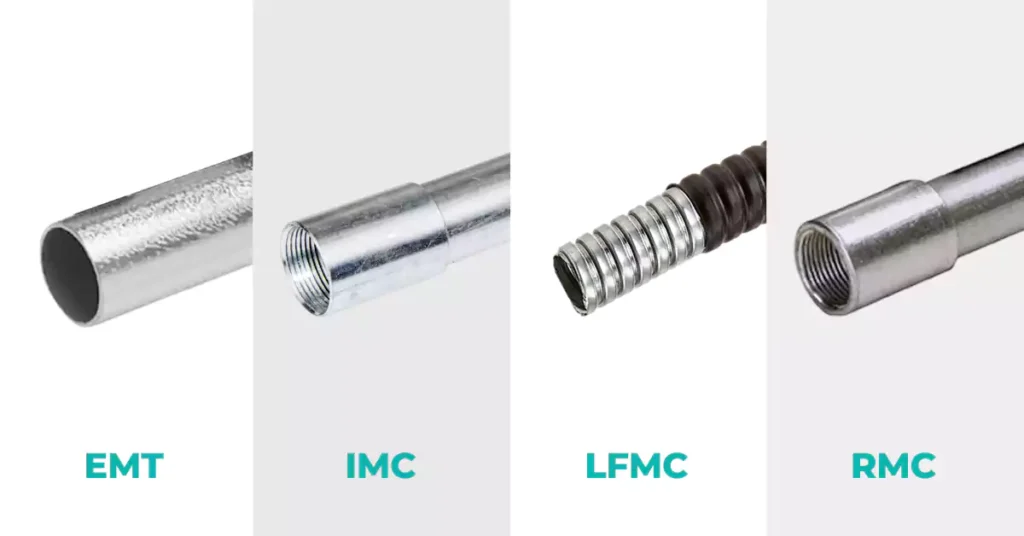
Metallic conduits are widely used in high voltage systems that demand maximum mechanical protection, electromagnetic shielding, and fire resistance. These rigid or flexible metal pathways provide robust containment and are commonly specified in industrial plants, power generation facilities, and critical infrastructure.
Types of Metallic Conduit
Rigid Metal Conduit (RMC)
RMC is a heavy-duty steel or aluminum conduit with threaded ends. It offers superior impact protection and excellent grounding capabilities. RMC is ideal for exposed outdoor environments, hazardous locations, and concrete-encased power runs.
Intermediate Metal Conduit (IMC)
IMC has thinner walls than RMC but still provides strong mechanical performance. It is lighter and easier to handle, while still complying with high voltage protection standards. IMC is commonly used in commercial buildings, elevated cable runs, and distribution vaults.
Electrical Metallic Tubing (EMT)
EMT is a lightweight, unthreaded conduit that is not typically rated for high voltage applications exposed to severe conditions. However, in controlled indoor high voltage rooms, EMT may be used when permitted by code and properly grounded.
Liquid-tight Flexible Metal Conduit (LFMC)
LFMC combines a flexible metallic core with a protective thermoplastic jacket. It is often used in motor control centers, equipment connections, or temporary installations, offering moderate mechanical protection, moisture resistance, and flexibility.
Pros of Metallic Conduit
High mechanical strength and crush resistance
Superior grounding and bonding characteristics
Fire-resistant and suitable for hazardous environments
Effective electromagnetic interference (EMI) shielding.
Cons of Metallic Conduit
Heavier and more difficult to install than non-metallic options
Susceptible to corrosion without proper coatings (e.g., galvanized steel)
Higher cost for materials and labor
Not ideal for corrosive or wet underground environments unless specially rated.
HDPE Conduit for High Voltage Systems

High-Density Polyethylene (HDPE) conduit is a flexible, durable, and corrosion-resistant nonmetallic conduit, widely used in underground high voltage installations, including transmission lines, wind farms, and solar farms.
5 Benefits of HDPE Conduit
- Flexibility: Supplied in coils or reels, HDPE can be installed in long runs with minimal joints, reducing installation time and potential failure points.
- Corrosion & Chemical Resistance: Resistant to water, salt, acids, and most chemicals—ideal for direct burial and harsh soil conditions.
- High Tensile Strength: Withstands pulling and trenchless installations such as horizontal directional drilling (HDD).
- UV Resistance (with additives): Outdoor-rated variants contain stabilizers to prevent UV degradation.
- Fusion Welding Compatibility: Enables watertight, airtight, and chemically resistant joints without solvent welding.
4 Limitations of HDPE Conduit
- Cannot be used aboveground without UV-stabilized versions
- Limited mechanical impact protection—requires additional shielding in high-traffic or exposed areas
- Requires specialized fusion tools for joining
- Not inherently flame-retardant unless treated
RTRC Conduit for High Voltage Systems
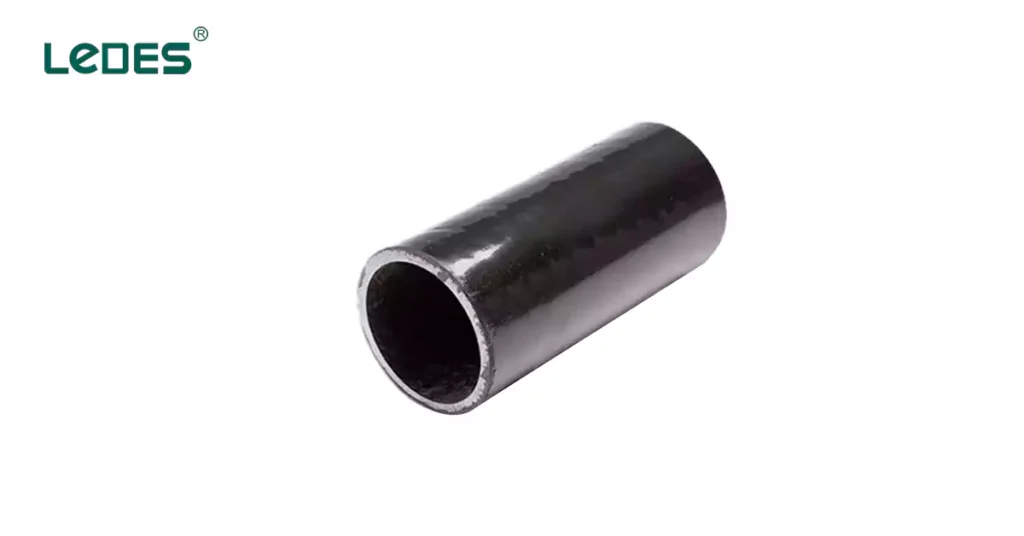
Reinforced Thermosetting Resin Conduit (RTRC) is a high-performance fiberglass-reinforced composite conduit used in demanding high voltage applications where strength, corrosion resistance, and lightweight construction are critical.
5 Benefits for RTRC Conduit
- Exceptional Strength-to-Weight Ratio: Lighter than metal, yet offers high mechanical and tensile strength.
- Corrosion & Chemical Resistance: Ideal for environments with exposure to chemicals, saltwater, or oil.
- Non-Conductive and EMI Shielding: Provides insulation and may include conductive inner layers for EMI shielding if needed.
- High Temperature Performance: Suitable for environments requiring thermal stability and fire performance.
- Long Service Life: Proven durability and reliability in power stations, tunnels, and refineries.
4 Limitations of RTRC Conduit
- Higher upfront material cost
- Requires special fittings and adhesives for installation
- Less commonly available compared to PVC or metal conduit
- Brittle if improperly handled during cold weather
Summary
Here are 10 common types of electrical conduit and features in high voltage systems:
Conduit Type | Material | Flexibility | Corrosion Resistance | EMI Shielding | Mechanical Strength | Fire Resistance | UV Resistance |
PVC (Sch 40/80) | Rigid Plastic | Low | Excellent | No | Moderate | Good | Only with UV-rated |
ENT | Plastic | High | Good | No | Low | Moderate | No |
Solar Conduit | UV-Resistant PVC | Low | Excellent | No | Moderate | Good | Yes |
RMC | Galvanized steel | None | Poor (unless coated) | Yes | Excellent | Excellent | Yes |
IMC | Steel | None | Moderate | Yes | High | Excellent | Yes |
LFMC | Steel and Jacket | High | Good (with jacket) | Yes | Moderate | Good | Yes |
HDPE | Polyethylene | Very high | Excellent | No | Moderate | Poor | Yes (with UV additive) |
RTRC | Fiberglass resin | Low | Excellent | Optional | High | Excellent | Yes |
Code Compliance for High Voltage Conduit System
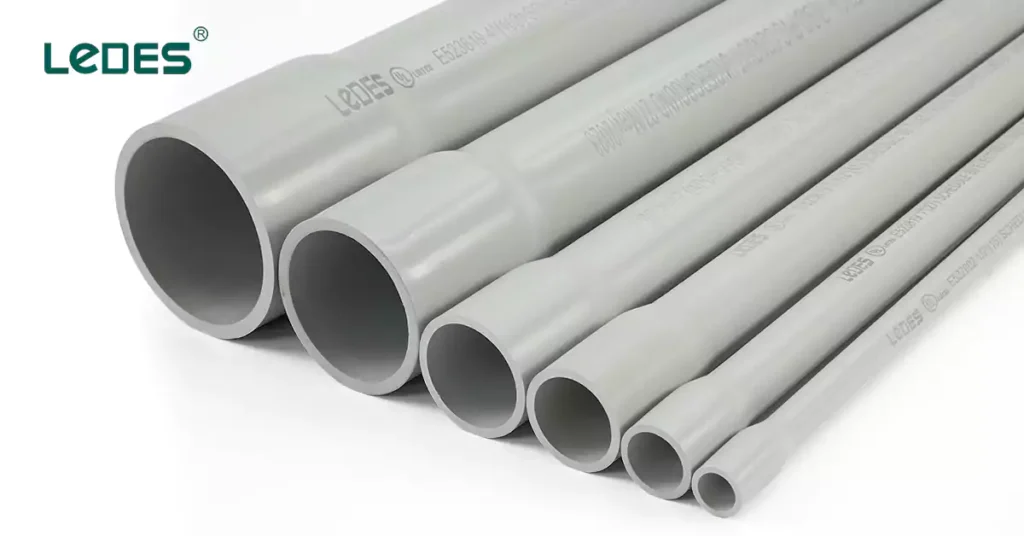
High voltage conduit systems, typically carrying voltages above 1,000V, must comply with rigorous codes and standards to ensure safety, durability, and operational integrity. These standards span across different regions and cover electrical performance, mechanical strength, installation methods, fire behavior, and more. Below are the most authoritative standards and regulations governing high voltage conduit systems around the world.
1. NEC (National Electrical Code - NFPA 70, USA)
The NEC provides comprehensive safety requirements for electrical wiring and equipment installation in the United States, including conduit systems. Key provisions for high voltage conduit include:
Voltage Classification
As of NEC 2017, systems above 1,000V (nominal) are considered high voltage. Older thresholds at 600V are still referenced in some parts.
Circuit Voltage | EMT, RTRC, PVC, HDPE Conduit | RMC, IMC Conduit |
Over 1000 V ac, 1500 V dc, through 22 kV | 18 in. (450mm) | 6 in. (150mm) |
Over 22 kV through 40 kV | 24 in. (600mm) | 6 in. (150mm) |
Over 40 kV | 30 in. (750mm) | 6 in. (150mm) |
Conductor Separation (Article 300.3)
Prohibits mixing conductors over 1,000V with those ≤1,000V in the same conduit or raceway unless adequate barriers or insulation ratings are provided.
Medium Voltage Conductors (Article 315)
Defines medium voltage as 2,001V to 35,000V, with specific insulation and cable protection rules for such installations.
Pro Tips: Read this expert guide to the NEC Code to help electricians and electrical contractors quickly understand the NEC’s requirements for electrical conduit.
2. UL (Underwriters Laboratories - USA)
UL sets testing and performance standards for electrical products, including these conduits that can be used for high voltage applications.
UL 651 – PVC Conduit and Fittings
Governs Schedule 40 and Schedule 80 rigid PVC conduit and sets performance requirements for them, such as:
Minimum tensile strength: To resist pulling forces of at least 5,000 psi.
Impact resistance: Ensure the conduit can protect conductors from external impact and physical damage.
Flame resistance: Must self-extinguish that prevent the fire spread.
Sunlight resistance: With UV-rated for outdoor and exposed environments, prevent conduit degrade over time.
90°C conductor use: Rated for high temperature conductor use up to 90°C, ensure safe use for high wiring loads.
UL 651A – HDPE Conduit
Covers requirements for HDPE conduit, widely used in high-voltage underground applications due to its chemical resistance and flexibility.
Notes: Want to learn more about the code compliance for PVC conduit in the UL 651 standard? Read our last post on the detailed explanation and testing of PVC conduit in the UL 651 code.
3. NEMA (National Electrical Manufacturers Association – USA)
NEMA develops mechanical and dimensional performance standards for conduit systems, often used in conjunction with UL and NEC.
NEMA TC 2 – Rigid PVC Conduit
Covers manufacturing standards for Schedule 40 and 80 rigid PVC conduit used in electrical systems.
NEMA TC 6 & 8 – Underground PVC Ducts
Defines mechanical performance for ducts used in direct burial (DB) and encased burial (EB) high-voltage systems.
NEMA TC 7 – Smooth-Wall HDPE Conduit
Addresses performance for coilable HDPE conduit, widely used in distribution voltage systems.
4. ASTM (American Society for Testing and Materials – USA)
ASTM standards validate conduit performance under real-world stress conditions.
ASTM F2160 – HDPE Conduit
Specifications for solid wall HDPE conduit used with power and communication cables, including dimensional tolerances and tensile strength.
ASTM F512 – Smooth-Wall PVC Conduit for Underground
Includes DB and EB types (e.g., DB-60, DB-100, EB-20). Defines:
Pipe stiffness classes
Material cell classifications per ASTM D1784 (e.g., 12254, 12264)
Impact resistance strength
Tips: The ASTM standard specifically makes detailed essentials for materials such as PVC and uPVC. Click the link above to learn more.
5. CSA (Canadian Standards Association - Canada)
CSA standards guide safe and reliable conduit use under the Canadian Electrical Code (CEC).
CSA C22.2 No. 211.2 – Rigid PVC Conduit
Conduit is unthreaded, joined by solvent cement, and rated for 75°C continuous operation.
This standard sets the performance requirements for PVC rigid conduit, including their physical strength, flame performance and impact resistance in cold temperatures.
CSA C22.2 No. 45.1 – Electrical Rigid Metal Conduits
Applies to electrical rigid metal conduits, requiring mechanical protection and corrosion resistance suitable for high-voltage environments.
CEC - Section 36 (High Voltage Installations)
When dealing with high voltage systems, defined in the CEC as systems exceeding 750 volts, a dedicated portion of the code applies: Section 36 – High-Voltage Installations.
This section introduces the requirements for high voltage systems, such as:
Equipment and Conduit Arrangement
Equipment rated for high voltage must be clearly identified and suitable for the system’s operating voltage.
All conduits, ducts, or raceways must be mechanically protected and non-combustible when entering or exiting high-voltage enclosures or switchgear rooms.
Reinforced conduit systems, such as RTRC (fiberglass), HDPE, or steel RMC, are often required depending on exposure risk, soil conditions, or fault levels.
Grounding and Bonding
All metal conduit used in HV systems must be properly bonded to ground using grounding bushings, jumpers, or listed connectors.
Shielded high voltage cables must be grounded at one or both ends to safely dissipate induced voltage and prevent shock hazards.
Separation from Other Systems
High-voltage raceways must not be installed in the same conduit, trench, duct, or enclosure as low-voltage systems (<750V) unless separated by a grounded metal barrier or a minimum distance is maintained, typically 300 mm or more depending on conditions.
This separation ensures insulation integrity and protects lower-voltage circuits from overvoltage exposure.
Cable Installation in Conduits
Thermoset-insulated or shielded cables rated for high voltage must be used within conduits. These cables must be suitable for wet or dry locations, based on application.
When installing in conduits, bending radius, pulling tensions, and cable ampacity must follow manufacturer and code limits.
Working Space and Enclosures
High-voltage electrical rooms and conduit terminations require clearance distances, dedicated entry, and in many cases, fire-rated barriers.
Pro Tips: CSA C22.2 especially lists the performance and testing of PVC conduits in detail, while CEC (CSA C22.1) mainly focuses on the requirements for the installation and code compliance of conduits. You can click on the link above to get more detailed information.
6. AS/NZS Standards (Australia/New Zealand)

Australia and New Zealand regulate electrical installations through the AS/NZS series of standards, with AS/NZS 3000:2018 (Electrical Installations – known as the Wiring Rules) being the most widely referenced. And AS/NZS 2053 series specify the requirements for conduit systems.
AS/NZS 2053 Series – Conduit Systems
2053.2: Rigid plain conduits and fittings.
2053.5: Corrugated conduits and fittings.
Requirements include:
Physical strength test such as impact, crushing.
Resistance to UV, chemicals, and flame.
Dimensions and classifications.
AS/NZS 3000 - Clause 7.8 (High Voltage Electrical Installations)
Section 7 of AS/NZS 3000 – Wiring Rules in Australia, addresses special electrical installations, and Clause 7.8 specifically covers high voltage installations. Key points include:
Applicability:
The requirements apply to installations operating above 1,000 V AC or 1,500 V DC, consistent with international definitions of high voltage.
Separation:
HV installations must be physically separated from LV installations to prevent accidental contact, reduce risk of flashover, and simplify identification and maintenance.
Warning Labels and Identification:
Conduits carrying HV conductors must be clearly marked with high-voltage warnings, color-coded (e.g., orange or red), and identified at regular intervals to avoid confusion with LV conduits.
Enclosures & Conduits:
HV cabling must be installed in mechanically protected enclosures, such as rigid conduits, ducting, or underground raceways.
These must be fire-resistant, impact-resistant, and non-conductive (unless proper bonding and earthing are ensured).
AS 2067 - Substations and High Voltage Installations Exceeding 1kV AC
AS 2067 sets out the design, construction, and performance requirements for electrical substations and other high voltage installations in Australia where voltages exceed 1,000 volts AC.
It applies to all types of high-voltage installations including:
Utility substations
Industrial and commercial HV systems
Renewable energy systems (like solar farms and wind farms)
Mining and large infrastructure facilities
Expert Tips: Reading the relevant content of AS/NZS 2053 can quickly understand the size, performance and tests of PVC conduit in countries such as Australia, while AS/NZS 3000 will tell you the specific requirements for wiring and conduit installation rules.
7. IEC (International Electrotechnical Commission)
IEC provides globally harmonized standards for conduit classification and electrical safety.
IEC 61386 – Conduit System Classification
Used worldwide for both low and high voltage applications. Defines:
Mechanical classes: resistance to impact, compression, bending, and pull.
Impact resistance: Measured in joules at specified temperatures.
Electrical continuity: for metallic systems.
Fire propagation resistance: conduit must resist flame and maintain function.
UV resistance and corrosion resistance for outdoor or buried systems
IEC 61936-1 – Power Installations Exceeding 1 kV AC
IEC 61936-1, titled “Power installations exceeding 1 kV AC – Part 1: Common rules”, is the definitive international standard for the design and installation of high-voltage systems operating above 1,000 volts AC and 1,500 volts DC.
Scope
IEC 61936-1 applies to:
Power plants
Substations
Industrial high-voltage installations
Cable routing and raceway systems
Underground and above-ground conduit and ducting systems for HV cabling
Mechanical Protection of Cables
High-voltage power cables must be mechanically protected in areas where they are exposed to mechanical damage, such as road crossings, substations, or public zones.
This may involve installation in conduits, ducts, trenches with reinforced covers, or concrete encasement.
Segregation and Identification
Conductors and conduit systems for different voltage levels must be segregated physically to prevent electrical hazards or cross-talk.
Conduits should be color-coded or clearly labeled to identify voltage class, especially when multiple systems run in proximity.
Earthing and Bonding of Metallic Conduits
Metallic conduits or cable sheaths must be bonded to the earthing system to ensure equipotential bonding and prevent hazardous voltages during faults.
Special attention is given to shielded cable systems, which must have proper termination and bonding at both ends to avoid circulating currents.
Thermal Considerations for Cable Routing
Conduit and duct systems must be designed considering ampacity derating factors due to mutual heating, burial depth, ambient temperatures, or solar exposure.
The standard emphasizes proper spacing, ventilation, or thermal backfill to avoid cable overheating in enclosed conduits.
Notes: The IEC (International Electrotechnical Commission) is a set of rules and standards that you must know. A quick understanding of the requirements of IEC 61386 for PVC conduits can help you comply with IEC and electrical installation requirements.
How to to Installation High Voltage Conduit - 12 Pro Tips
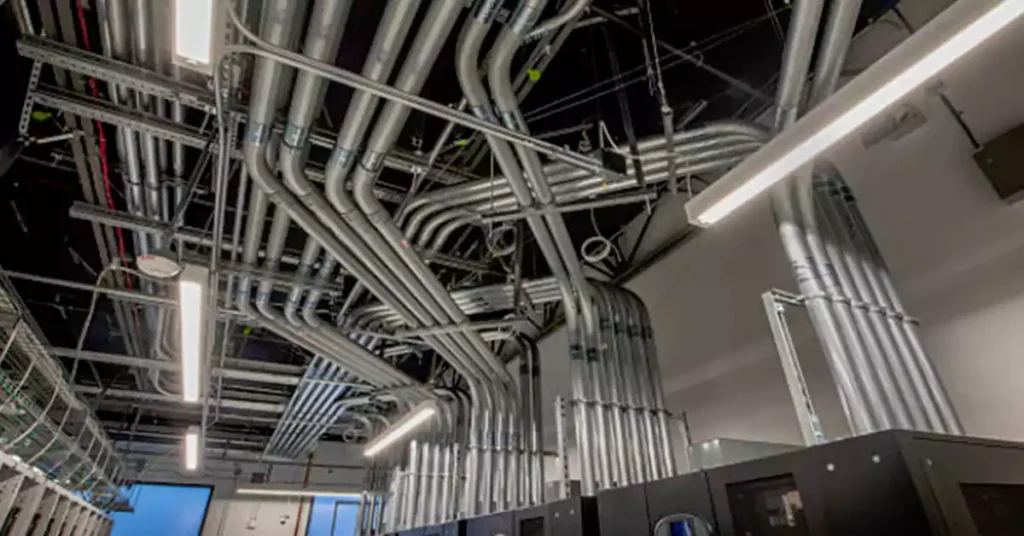
Installing conduit systems for high voltage applications demands precision, compliance, and a clear understanding of environmental, mechanical, and electrical safety considerations. Improper conduit installation can result in insulation failure, overheating, physical damage to conductors, or even catastrophic arc-flash events. The following best practices ensure reliable performance, regulatory compliance, and long-term system integrity.
1. Planning and Site Assessment
Before trenching or installing any conduit:
- Conduct a detailed site survey to identify underground utilities, soil composition, water tables, and possible obstructions.
- Perform a load and system voltage analysis to determine conduit material, size, and route based on fault current, temperature rise, and electromagnetic interference.
- Comply with clearance regulations: Maintain required minimum distances from buildings, water lines, gas lines, and other electrical systems in accordance with NEC, AS/NZS 3000, or CEC standards.
2. Conduit Sizing and Bending
Follow conduit fill requirements per NEC Chapter 9 (Table 1 and Annex C) or applicable local standards to avoid overfilling.
Ensure minimum bending radius is maintained to prevent insulation damage during cable pulling.
Use sweep bends instead of sharp elbows for smoother cable installation, especially with rigid PVC and RTRC.
3. Depth and Burial Depth
For underground installations, conduits must be buried to the required depth depending on voltage level, conduit type, and installation location. Codes such as NEC table 305.15(A) and CEC table 53 have specify the requirements.
4. Separation and Segregation
Maintain voltage separation: High voltage cables must not share raceways with low-voltage or signal circuits unless barriers or other protection measures are used.
For multiple circuits, use separate conduits or provide physical barriers within common trenches to mitigate fault risks and induced voltages.
5. Conduit Jointing and Sealing
Solvent Welding for PVC: Use only certified solvent cements for bonding PVC joints, allowing proper curing time to ensure integrity.
Gasketed Couplings: For buried metallic conduit, use watertight or compression-type fittings rated for the installation environment.
Sealing Requirements: NEC requires sealing conduit ends where temperature differences can cause moisture condensation (e.g., conduit passing between warm indoor and cold outdoor environments).
6. Expansion and Contraction Management
Thermal Expansion: Non-metallic conduits like PVC expand significantly with temperature changes. Install expansion fittings or bends in long runs as per manufacturer guidelines or NEC.
Anchoring and Spacing: Proper support spacing must be observed – PVC requires closer support intervals (~3 ft) than steel or RTRC (~10 ft), especially in vertical application
7. Cable Pulling Considerations
Conduit Cleanliness: Clean and swab conduits before pulling conductors to remove debris that could damage insulation.
Lubrication: Use compatible pulling lubricants to reduce friction and prevent jacket damage.
Pulling Tension: Ensure pulling tension and sidewall pressure do not exceed cable manufacturer’s limits. Use pulling eyes or basket grips to distribute force evenly.
Segmented Pulls: For long conduit runs or complex bends, plan segmented cable pulls with pull boxes or intermediate vaults.
8. Grounding and Bonding
Metallic Conduits: Must be properly grounded per NEC Article 250, IEC 61936-1, or AS 2067. Bond all metallic fittings and maintain electrical continuity throughout the system.
Non-metallic Conduits: Use separate grounding conductors within the raceway. Conductors must be sized appropriately for the fault current level.
9. Marking and Identification
Color Coding: Use standard colors or labeling (e.g., red for HV circuits, grey for PVC electrical conduit) based on national or local codes.
Warning Tape: Install detectable warning tape 12–18 inches above buried conduits to alert future excavators.
Permanent Labels: Use weatherproof or engraved labels to identify voltage level, circuit purpose, and conduit routing
10. Environmental and Fire Protection
UV Protection: For outdoor PVC conduits, select UV-rated formulations or use shielding to prevent degradation.
Fire Barriers: In fire-rated walls or floors, seal conduit penetrations with approved firestop systems.
Moisture and Corrosion Resistance: Use corrosion-resistant coatings for metallic conduits, and ensure HDPE or PVC conduits are watertight in wet locations.
11. Inspection and Testing
Visual and Mechanical Checks: Verify proper jointing, support spacing, and alignment.
Conduit Integrity Test: Pressure testing may be conducted (especially for HDPE systems) to verify no leaks or deformities.
Cable Insulation Testing: After installation, perform insulation resistance tests (e.g., megger testing) before energizing high-voltage conductors.
12. Documentation and Record-Keeping
As-Built Drawings: Maintain accurate records of conduit routing, pull box locations, and burial depths.
Inspection Records: Document inspections, approvals, and conformity to codes and manufacturer instructions.
Maintenance Access: Ensure pull points, junctions, and terminations are accessible for future maintenance or system upgrades.
By following these best practices, high voltage conduit installations can meet rigorous safety, performance, and compliance requirements while ensuring operational longevity in even the most demanding environments.
How to Maintain the High Voltage PVC Conduit - 3 Tips
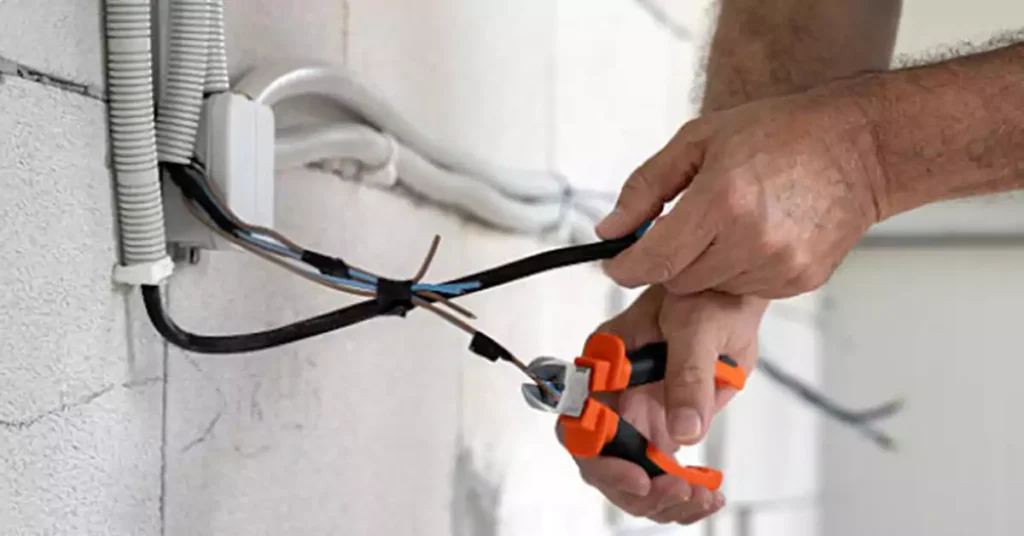
High-voltage PVC conduit systems are widely used due to their non-conductive properties, chemical resistance, and ease of installation. However, maintaining their long-term performance, especially in demanding environments such as power distribution, substations, and renewable energy systems, requires a combination of proper preventative maintenance, effective troubleshooting, and attention to environmental and material factors.
1. Preventive Maintenance Strategies
Regular Inspection and Cleaning
Routine visual inspections should be performed at least semi-annually, or more frequently in harsh environments (e.g., coastal, industrial, high UV areas).
Cleaning should involve non-abrasive materials and PVC-safe solutions. Harsh chemicals or strong solvents must be avoided, as they can weaken the conduit structure or coating.
Temperature Control and Expansion Management
PVC expands and contracts with temperature changes. To prevent warping, buckling, or joint separation:
Use expansion fittings where long runs are installed in areas with wide temperature fluctuations.
Maintain proper spacing of supports (e.g., every 3 ft or 0.9 m for horizontal runs).
In outdoor or high-temperature areas, consider heat shields or enclosures for thermal protection.
Moisture Management
Even though PVC is water-resistant, conduit systems—especially underground ones—must be sealed to prevent moisture ingress. Recommended practices include:
Using weatherproof or IP-rated junction boxes and fittings.
Applying gaskets and sealing compounds at connections.
Periodically inspecting for condensation or signs of water entry in pull boxes or terminations.
UV Protection
UV exposure causes surface chalking, brittleness, and degradation over time. For outdoor installations:
Use UV-resistant or sunlight-resistant PVC conduit, as rated by UL 651.
Apply UV-protective coatings (e.g., acrylic-based paints rated for plastic).
When feasible, install conduit under shelter or shade structures.
Chemical Compatibility
In industrial or petrochemical zones, conduit may be exposed to solvents, oils, or acids:
Always verify the chemical compatibility of PVC before installation.
In aggressive environments, use chemically resistant PVC variants or protective sleeves/barriers.
Proper Mechanical Support
Incorrect support can lead to sagging and long-term stress:
Use manufacturer-recommended clamps and hangers.
Avoid over-tightening, which may cause localized deformation.
Ensure conduit is well aligned and free from excessive mechanical tension.
2. Troubleshooting and Repair Procedures
Fault Detection and Location
PVC conduit systems themselves are non-conductive, so electrical faults occur in the enclosed cables. However, troubleshooting may still involve inspecting the conduit path for physical damage. Tools include:
Time Domain Reflectometry (TDR) to locate cable faults.
Surge Pulse or Arc Reflection methods for high-voltage cables.
Visual inspections for collapsed or water-filled conduits.
Repair Techniques
If conduit damage is detected:
Cut out and replace damaged segments with identical material and rating.
Reconnect using solvent welding (for PVC) or mechanical couplings where allowed.
Ensure cable protection during repairs to prevent insulation damage.
3. Factors Influencing Long-Term Performance
Material Quality
Standard rigid PVC offers durability and resistance to many chemicals and weather conditions.
CPVC (chlorinated PVC) and solar-grade UPVC offer improved thermal stability and aging resistance.
Environmental Conditions
Harsh environmental conditions can drastically reduce conduit lifespan:
UV exposure leads to embrittlement.
Freeze-thaw cycles can cause cracking.
Acidic soils or industrial vapors may chemically attack the conduit.
Selecting the correct material rating and protective systems is critical to mitigate these effects.
Installation Quality
A conduit system is only as strong as its installation. Long-term issues often stem from:
Inadequate burial depth (per NEC 300.5 or AS/NZS 3000 Table C1).
Over-bending, violating minimum bend radii.
Overfilling beyond allowable conduit fill ratios (NEC Chapter 9, Table 1).
Poor joint preparation or use of incorrect solvent cement.
Innovations and Market Trends in High Voltage Conduit
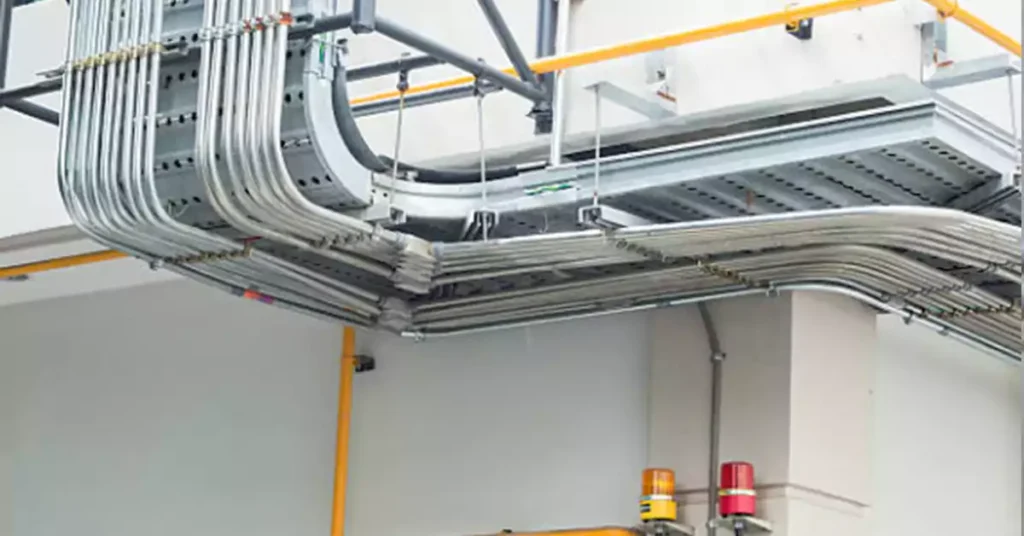
As global demand for energy infrastructure grows in scale and complexity, the high voltage conduit industry is entering a transformative era. Innovations in material science, smart technologies, and sustainable manufacturing are converging to redefine how conduit systems are designed, installed, and maintained. Simultaneously, market dynamics which is driven by electrification, digitalization, and environmental imperatives, are shaping the next generation of high voltage conduit solutions.
Advancements in Materials and Conduit Design
Advanced Polymers and Coatings
Modern conduit systems are increasingly built with advanced polymer formulations and engineered coatings that improve performance in high-voltage environments:
- UV-stabilized UPVC and LSZH PVC provide better weather resistance and fire safety in solar power and utility-scale projects.
- Halogen-free and low-smoke variants enhance occupant safety and asset protection in enclosed or mission-critical installations like substations, data centers, and tunnels.
- Enhanced CPVC materials offer higher thermal stability for heavy-duty applications, such as EV charging infrastructure and industrial automation.
Flexible and Sealed Systems
To accommodate movement caused by seismic activity, thermal expansion, or structural shifts:
- Expansion-deflection couplings and integrated sealing systems are being adopted for watertight and dustproof installations, especially in underground or outdoor environments.
- These solutions are crucial for protecting wiring in power distribution networks where conduit systems must remain stable despite environmental stress.
Installation-Efficient Designs
Time- and labor-saving innovations are becoming industry norms:
- Tool-free fittings, snap-lock mechanisms, and modular junction boxes simplify installation and retrofitting.
- Continuous-length conduit options, particularly in HDPE systems, reduce the need for jointing, accelerating installation on long underground runs.
Smart Grid Integration and Digitalization
The global shift toward intelligent energy networks is influencing how high voltage conduit systems are engineered.
Conduits in Smart Infrastructure
High voltage conduit now plays a critical role in housing both power and low-voltage communication cables:
- In smart grid and energy storage systems (ESS), proper separation of data, control, and power cables within conduits helps minimize EMI and improves operational reliability.
- Advanced conduit designs allow for co-routing with shielding, protecting sensitive monitoring equipment from electrical interference.
Digital Twins and BIM Modeling
Electrical digital twins – virtual representations of real-world grid infrastructure, enable real-time data synchronization, predictive maintenance, and system optimization.
Integration with Building Information Modeling (BIM) supports precise conduit layout planning, clash detection, and resource forecasting from the design stage onward.
These tools enhance the accuracy and accountability of electrical designs, particularly in large-scale infrastructure and utility projects.
AI and Automation in Manufacturing
Artificial intelligence is increasingly utilized to enhance conduit manufacturing:
AI-driven inspection and defect detection improve product quality and safety.
Predictive analytics optimize production efficiency and material usage.
In some sectors, AI also supports environmental applications, such as oil spill detection, indicating its expanding role in energy-related infrastructure.
Sustainability and Circular Design
Sustainability is no longer optional, it’s a core requirement for modern electrical systems, and conduit solutions are evolving accordingly.
Recycled and Eco-Friendly Materials
- Recycled PVC is gaining traction for its mechanical strength, chemical resistance, and low environmental impact.
- While not infinitely recyclable like metals, plastics such as PVC and HDPE can be mechanically recycled multiple times with minimal property loss.
- Low-carbon manufacturing of PVC and CPVC (which consume less energy than traditional metal conduits) contributes to a smaller carbon footprint.
Durability and Lifecycle Efficiency
- PVC conduits have proven life expectancies of 50 – 100+ years under optimal conditions, reducing waste through longevity.
- Their resistance to corrosion, moisture, and UV also lowers maintenance needs and prolongs replacement cycles.
- Similarly, steel conduits remain a sustainable choice due to their recyclability and long service life in demanding environments.
Emerging Application Trends and Market Drivers
Several high-growth industries are catalyzing change in conduit design and deployment:
Renewable Energy
The expansion of solar photovoltaic systems and wind farms requires robust, UV- and heat-resistant conduit systems to house high voltage cabling.
In solar farms, conduits must withstand long-term outdoor exposure, extreme heat, and mechanical stress from trenching or wildlife.
New Energy Vehicles (NEVs) and EV Infrastructure
The rise of electric vehicles (EVs) and NEVs is driving demand for high-performance conduit systems capable of housing high-voltage DC cables and managing elevated thermal loads at fast-charging stations.
Data Centers and Critical Infrastructure
As global data consumption increases, data centers are expanding rapidly, requiring fire-safe, EMI-shielded, and precisely routed conduit systems for high voltage and fiber optics.
Conduits must ensure separation of sensitive data and power cables and meet stringent codes for fire resistance, ventilation, and accessibility.
Energy Storage Systems (ESS)
The growth of battery storage systems for grid balancing and renewable integration demands conduit systems with tight EMI shielding and advanced thermal management to support safety and efficiency.
Urbanization and Smart Cities
Urban densification is increasing the need for underground electrical infrastructure. PVC and HDPE conduits provide space-efficient, corrosion-resistant, and long-life solutions.
Smart city applications require robust protection for a mix of power, data, and control circuits within congested underground pathways.
Conclusion
High voltage conduit systems are the unsung backbone of modern power infrastructure, quietly ensuring the safe transmission of energy across industrial plants, data centers, smart cities, renewable energy farms, and electric vehicle networks. As energy demand grows more complex and global electrification accelerates, the conduit systems protecting high voltage cabling must meet ever-higher standards of durability, safety, efficiency, and environmental responsibility.
This guide has examined every critical dimension of high voltage conduit systems, from their definitions and classifications to compliance standards, installation best practices, maintenance strategies, and emerging trends. Whether constructed from PVC, HDPE, steel, or advanced polymer blends, conduit systems are evolving rapidly driven by technological innovation, regulatory advancement, and global efforts toward sustainability and resilience.
As infrastructure ages and the energy sector transitions to clean and decentralized models, high voltage conduit will continue to play a critical role in future-proofing power systems. Engineers, facility owners, and system designers must adopt a forward-thinking approach, one that balances technical requirements with long-term operational and environmental goals.
In the decade ahead, the high voltage conduit industry will not just follow change; it will help lead it, laying the pathways for a safer, smarter, and more electrified world.
FAQs
What is considered "high voltage" in electrical systems?
“High voltage” typically refers to systems operating above 1,000 volts, as per IEEE and IEC definitions. The NEC redefined “high voltage” equipment thresholds from 600V to 1,000V. It may define differently based on different codes and regulations.
Why is electrical conduit essential for high voltage systems?
Electrical conduit is critical for physical protection, environmental sealing, and code compliance. It shields high voltage cables from mechanical damage, moisture, UV rays, and chemical corrosion, while also providing segregation, EMI reduction, and easier maintenance access. For high voltage systems, conduits also play a key role in thermal management and grounding architecture.
What are the main types of conduit used for high voltage applications?
Common conduit types for high voltage include:
Rigid PVC (Schedule 40/80) – corrosion-resistant and cost-effective
HDPE (High-Density Polyethylene) – ideal for long continuous runs and directional boring
RTRC (Fiberglass Reinforced Conduit) – lightweight, non-corrosive, flame-resistant
GRC (Galvanized Rigid Conduit), IMC, RMC – used in exposed or industrial-grade applications, offering superior mechanical protection
What are the key advantages of using PVC conduit for high voltage applications?
PVC conduit provides:
Excellent corrosion and chemical resistance
Non-conductive insulation barrier
Lightweight and easy installation
Cost-effectiveness
Flame-retardant and self-extinguishing options
UV-resistant variants for outdoor use
These traits make it especially suitable for buried or enclosed installations.
What are the limitations or disadvantages of PVC conduit?
PVC is not as strong as metal or fiberglass under impact or crush loads. It may deform under high heat and requires support for long horizontal runs. While flame retardant options exist, standard PVC can release toxic halogen gases when burned. Also, thermal expansion requires the use of expansion fittings in wide temperature range installations.
What are the typical burial depth requirements for high voltage conduit?
Per NEC Table 305.15(A):
For PVC conduit that Over 1000 V ac, 1500 V dc, through 22 kV is 18 inches.
Over 22 kV through 40 kV is 24 inches.
Over 40 kV is 30 inches.
Can low voltage and high voltage wires be run in the same conduit?
Generally no. NEC requires physical separation to prevent interference, overheating, and safety risks. Low voltage (e.g., data/communication) and high voltage circuits must be:
Separated by a barrier or run in different conduits
Shielded if proximity is unavoidable (e.g., metal conduit)
This reduces EMI, cross-talk, and shock hazards.
Why is thermal management important for high voltage conduit systems?
High current loads, such as in EV DC fast chargers, generate significant heat. Improper heat dissipation can degrade wire insulation, warp PVC, and cause faults. Solutions include:
Using heat-rated or UV-stabilized conduits
Ensuring airflow, spacing, and ventilation
Avoiding overfilling conduits to allow for heat dissipation
Is PVC conduit safe for underground high-voltage cable runs?
Yes. Schedule 80 PVC is widely used in direct-buried or concrete-encased underground HV installations. It offers:
Corrosion resistance
High dielectric strength
High physical strength
Use proper backfill material, trench depth, and warning tape to ensure long-term safety.
What are the most common failure modes in high-voltage PVC conduit systems?
Frequent issues include:
Improper joint solvent welding leading to leaks
UV degradation from sun exposure
Thermal deformation from current overload
Crush or collapse from poor burial/backfill practices
Water ingress due to failed seals or couplings
Improper grounding in mixed-material systems
Inadequate space and separation from other power systems
What is the maximum voltage rating for rigid PVC conduit?
Rigid PVC conduit itself is a non-conductive material, so it does not have a voltage rating in the same sense as electrical cables. However, when used as part of an electrical system, the National Electrical Code (NEC) permits rigid PVC conduit (Schedule 40 and 80) to be used in applications up to 1,000 volts in most situations. In some cases, and with proper design and installation practices, it can be used in systems exceeding 1,000 volts, particularly in medium and high voltage utility or solar installations, but this depends on local codes, installation conditions, and product certification.
Are there fire-rated or flame-retardant PVC conduit options for high-voltage use?
Yes, fire-rated and flame-retardant PVC conduit options are available, specifically engineered to meet the safety demands of high-voltage and high-risk environments. These include:
- UL 94 V-0 or 5VA-rated conduits – classified for flame resistance and often required in critical applications.
- Plenum-rated or FT4/FT6-rated conduits (per CSA standards) – designed for use in air-handling spaces and vertical shafts where flame spread must be limited.
Such conduits are commonly used in data centers, utility buildings, industrial plants, tunnels, and transportation infrastructure where both high-voltage protection and fire safety are critical. Be sure the selected conduit meets the required UL, NEC, or local fire code standards for your application.


